Ireland’s skies are home to an array of birds of prey, from the swift Peregrine Falcon to the stately Golden Eagle. This guide offers direct insight into where to find these raptors and their ecological importance, specifically focusing on the bird of prey Ireland has to offer.
Key Takeaways
Ireland’s birds of prey like Golden Eagles and Hen Harriers play a crucial role in the ecosystem by regulating prey populations and maintaining the ecological balance.
Conservation efforts in Ireland have led to the successful reintroduction and comeback of several birds of prey, such as the Golden Eagle and Red Kite, showcasing the resilience of nature.
Birds of prey serve as effective pest control agents, contributing to the health of the ecosystem by keeping rodent and insect populations in check.
Ireland’s Sky Hunters: An Overview of Birds of Prey
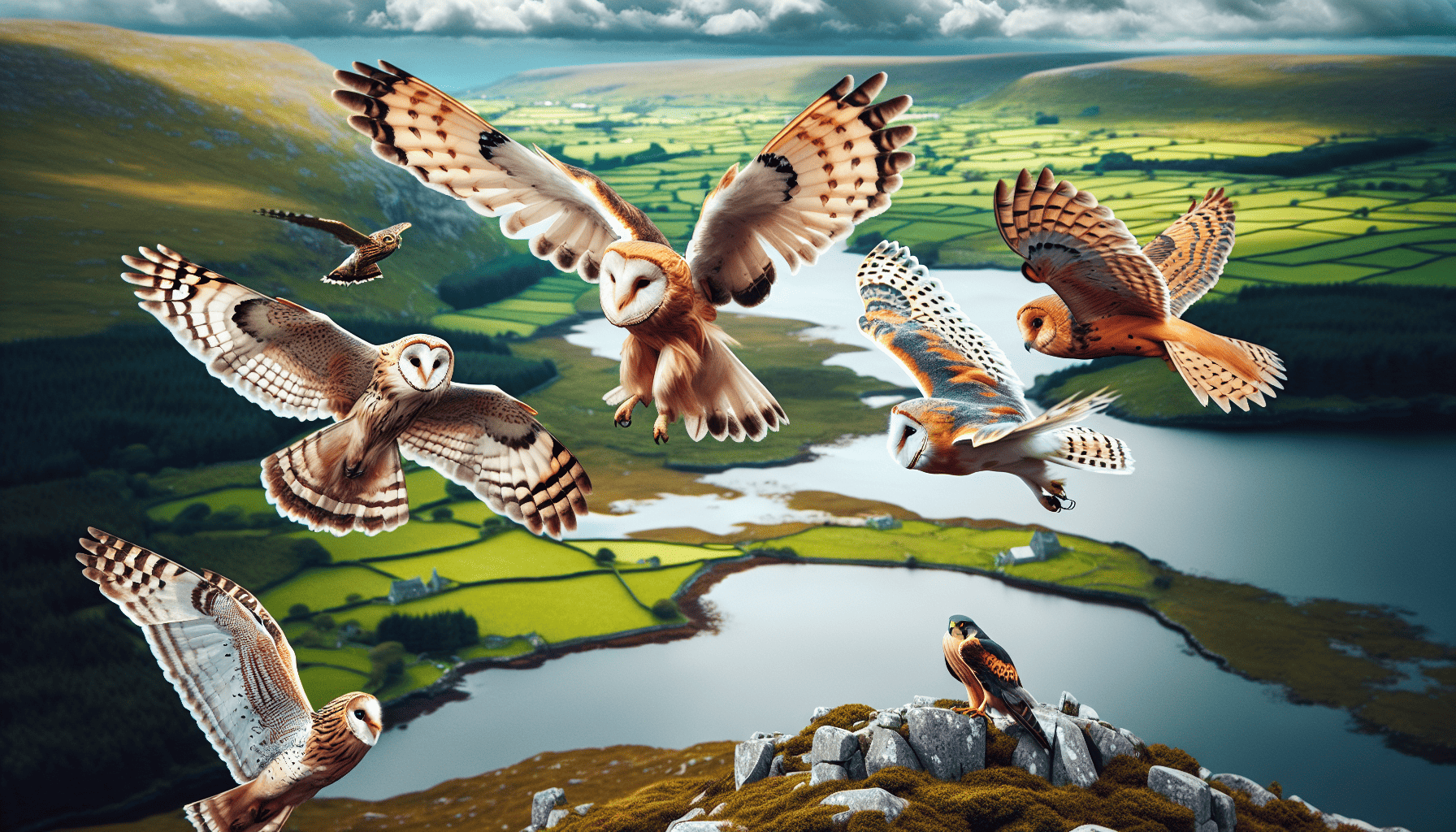
Birds of prey, such as:
Golden Eagle
Barn Owl
Hen Harrier
Peregrine Falcon
Male and Female Kestrels
are some of the top bird species in the Irish ecosystem. These birds, known for their hunting prowess and impressive flight capabilities, play an integral role in keeping the food web in check, thus ensuring the stability of the entire ecosystem.
You can find these raptors across various regions of Ireland. For instance, County Donegal is one of the best spots to see birds of prey like Golden Eagles and White Tailed Eagles. What distinguishes these birds? Well, Ireland’s birds of prey are known for their hovering flight during hunting. The Peregrine Falcon, Kestrel, Merlin, Sparrowhawk, and Hen Harrier are some that you’re likely to see around.
While their hunting prowess is remarkable, the role these birds play in the ecosystem is even more astounding. Their role in regulating prey species populations helps sustain a delicate balance, allowing other flora and fauna to flourish. They are vital to the overall health of Ireland’s ecological system.
Majestic Golden Eagles: Ireland’s Regal Raptors
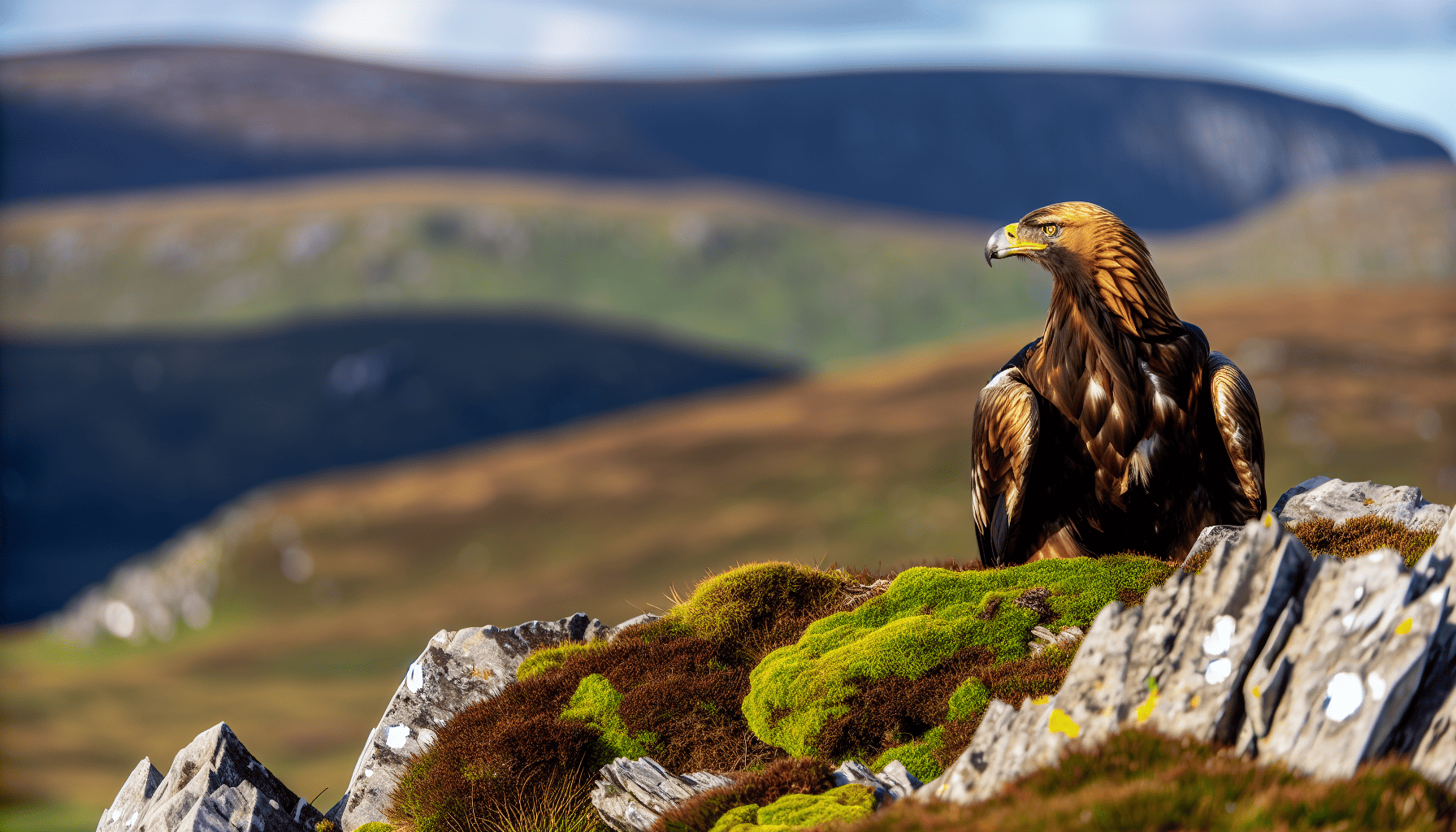
Unquestionably, the impressive size and hunting prowess of Golden Eagles make them one of Ireland’s most majestic sky spectacles. Once widespread in Ireland, these regal raptors faced a decline but are now making a comeback, thanks to concerted reintroduction efforts.
Golden Eagles, recognizable by their dark brown body, golden head and neck, and a wingspan of about 2.2 meters, rank as the second-largest bird of prey in Ireland. Their presence in the Irish skies is a testament to the success of conservation efforts and a symbol of the resilience of nature.
These majestic birds can be spotted in the following counties:
Donegal
Tyrone
Fermanagh
Derry
Leitrim
Sometimes, they can even be seen as far south as north Kerry. These areas, with their mountainous terrain, are perfect for Golden Eagles, allowing them to soar high and hunt effectively.
The Elusive Hen Harrier: Upland Guardian
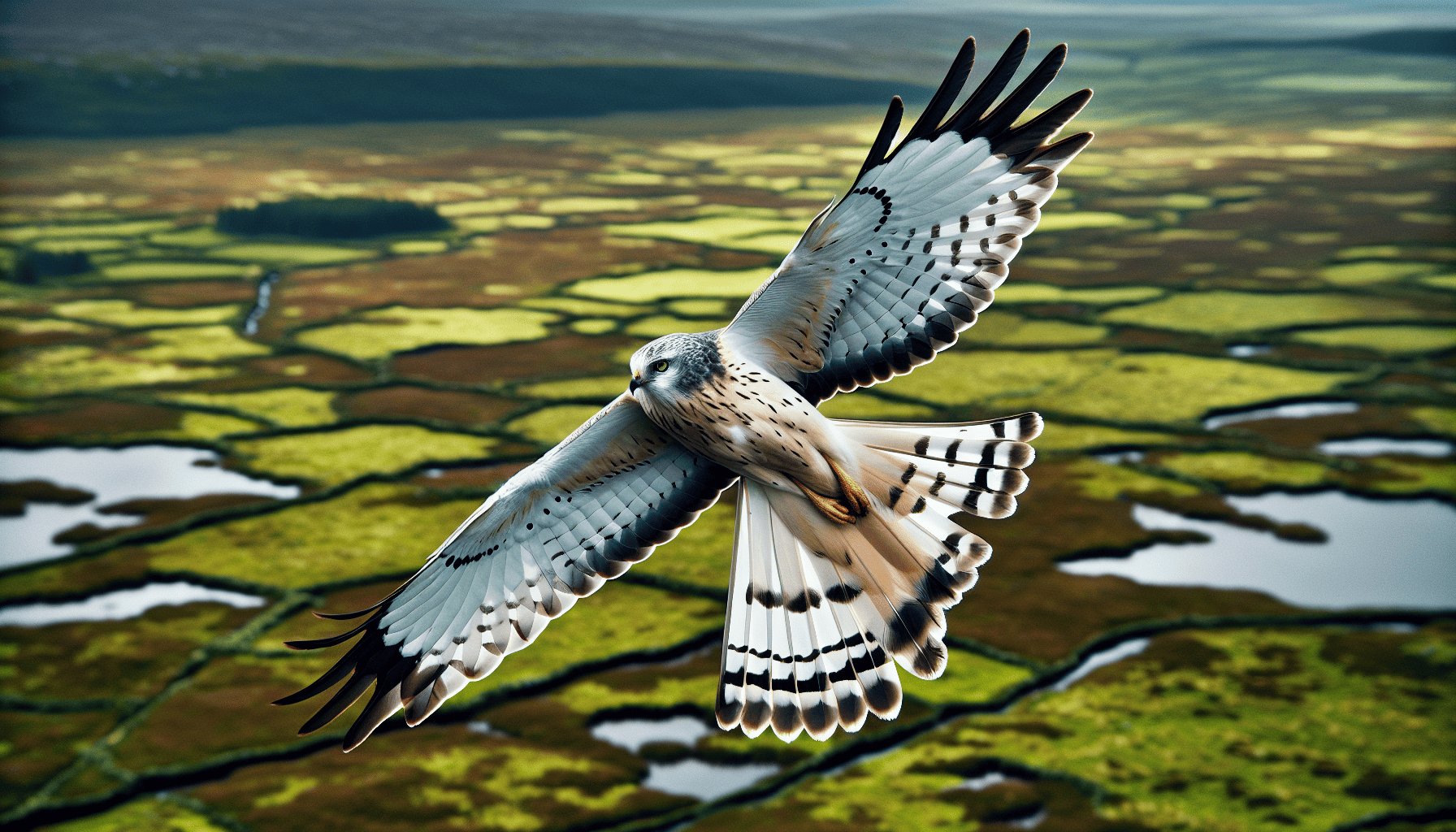
The Hen Harrier, a bird of prey found in the uplands and bogs of Ireland, is renowned for its unique plumage and breathtaking aerial displays. With long legs, a long tail, and a small, owl-like face, this bird stands out among its peers, such as the marsh harrier. What’s more, the males are silvery grey with dark wingtips and a white rump, while the females are brown with a white rump and white tail bars, making them easily distinguishable.
Hen Harriers are typically spotted in the following counties in Ireland:
Laois
Tipperary
Cork
Clare
Limerick
Galway
Monaghan
Cavan
They prefer nesting in habitats primarily made up of heather. This preference for upland areas and their diet consisting of small birds and mammals make them an integral part of Ireland’s ecosystem.
The Hen Harriers’ hunting methods, which involve skillfully hovering over their hunting grounds before expertly swooping down on unsuspecting prey, are truly impressive. Their resilience, demonstrated by their capacity to adapt and thrive in Ireland’s upland and bog ecosystems, is vital for maintaining the balance of these unique ecosystems.
Peregrine Falcons: Speedsters of the Skies
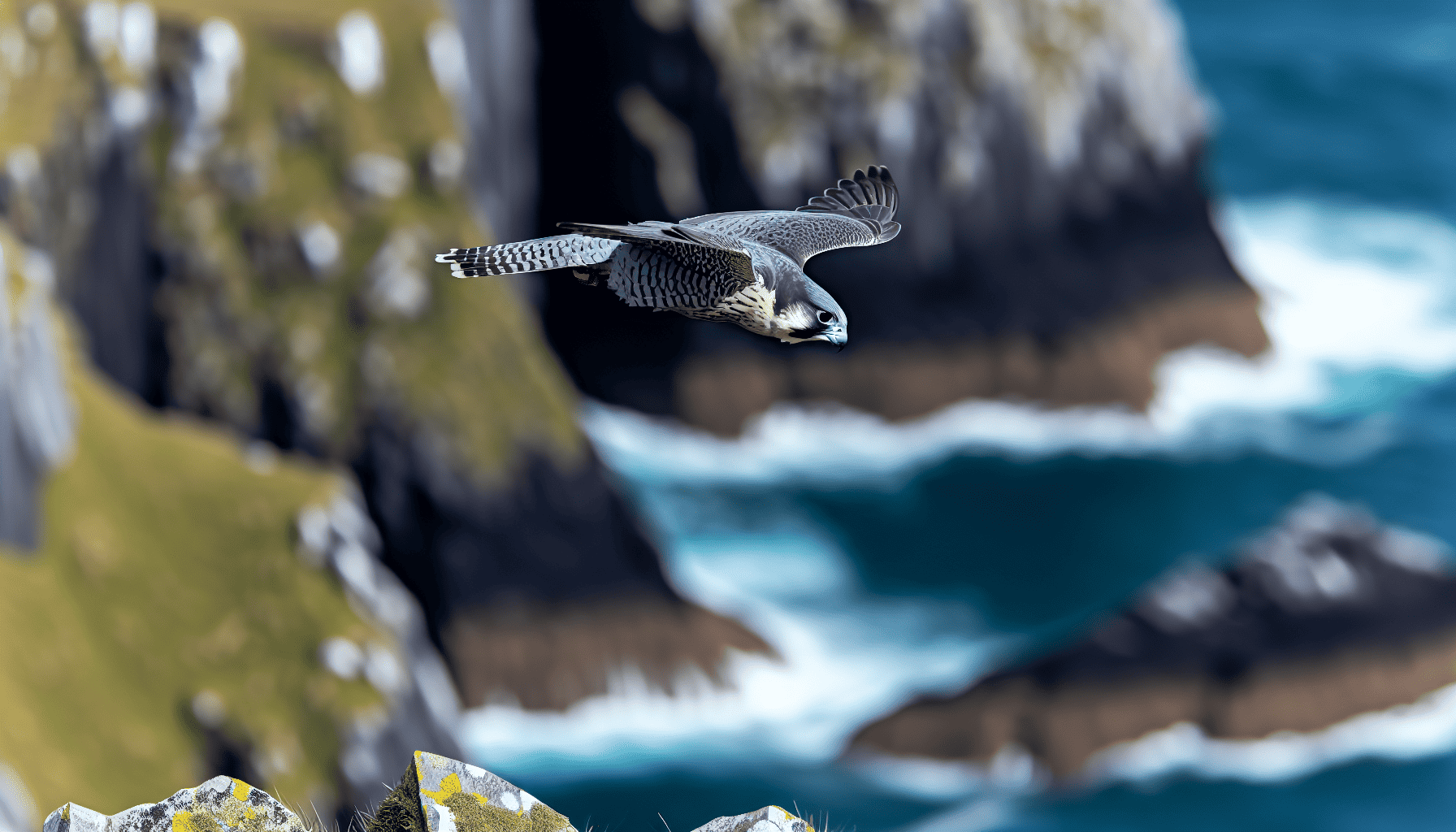
Peregrine Falcons are the fastest birds in the world, known for their incredible hunting skills and speed. With long, tapered wings for maneuvering at high speeds and strong feet and talons for striking and grasping prey, these swift predators are a fascinating sight.
As adept hunters, these birds swoop down from great heights at high velocities to catch their prey, typically songbirds, waders, pigeons, and ducks. Their astounding agility and speed are evident as they can hit speeds over 320 km/h (200 mph) when diving.
Despite their impressive hunting prowess, Peregrine Falcons are not picky about their habitats. They are found in upland crags, coastal cliffs, and, lately, tall buildings in cities. The adaptability and skill of Peregrine Falcons rank them among Ireland’s most spectacular birds of prey.
White Tailed Sea Eagle: Ireland’s Second Largest Bird
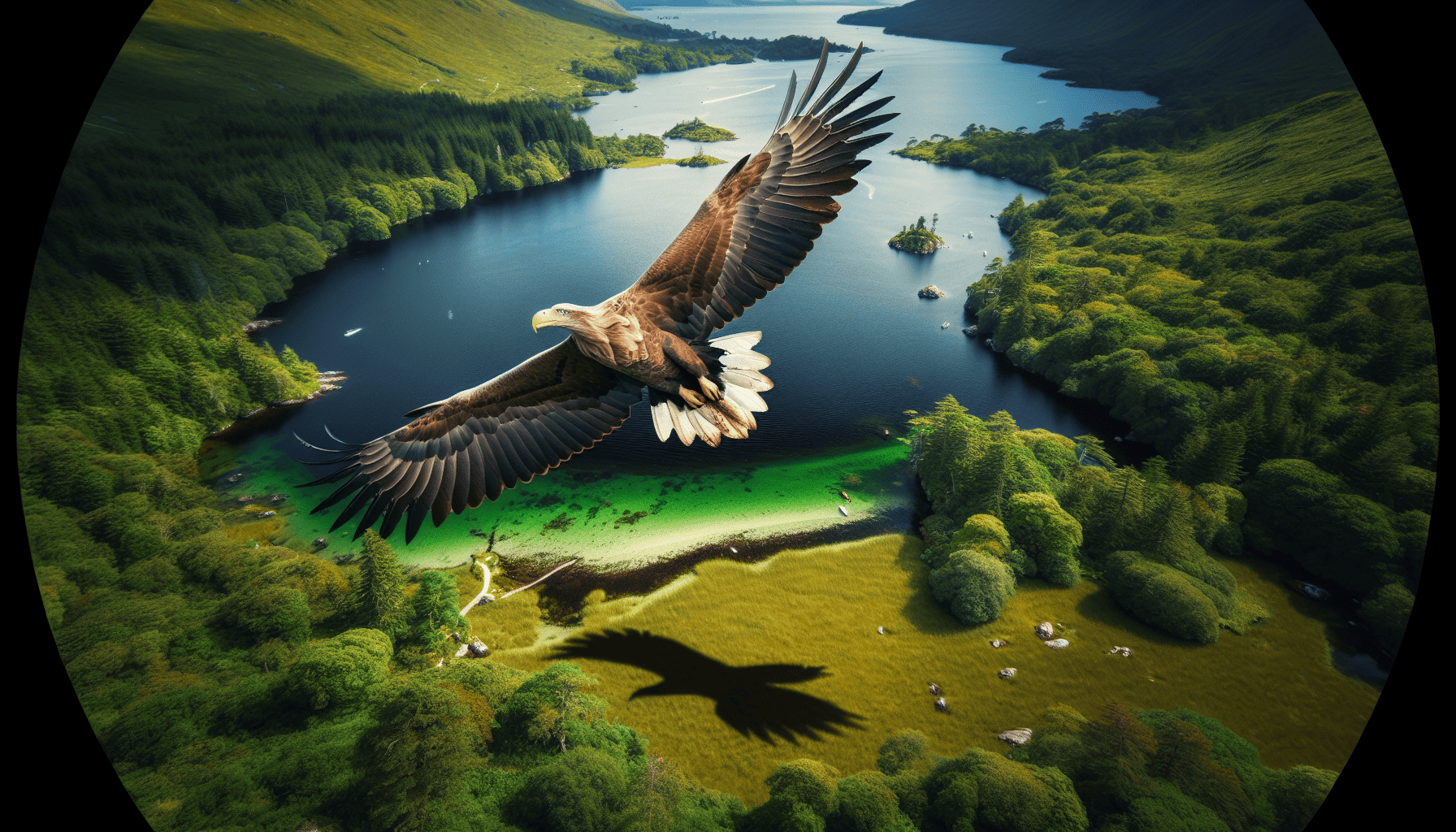
White Tailed Sea Eagles are a sight to behold, with their brown feathers, lighter head, and a noticeable white tail. Reintroduced to Ireland in 2007, these birds have made a successful comeback and are now the country’s second-largest bird of prey.
These eagles have adapted well to their environment in Ireland. They can nest in trees, prefer cliffs, or even on the ground, but so far, nests have only been recorded in trees. Their chosen locales typically include coasts, large lakes, and rivers, making them a common sight in these areas.
White Tailed Sea Eagles feed on a diet of:
fish
water birds
dead sheep and seals (occasionally)
medium-sized mammals (sometimes)
Their dietary habits contribute significantly to the ecosystem by helping control the populations of their prey species.
Red Kite Resurgence: From Extinction to Expansion
Red Kites, once extinct in Ireland, have made a remarkable comeback through reintroduction efforts. Today, these birds, with their russet brown body and forked tail, are a common sight in Dublin, Down, and Wicklow, marking a significant win for conservation efforts.
The resurgence of Red Kites is a testament to the success of conservation efforts. The program, which began in 2007, has seen the population of these birds steadily increase, indicating a positive trend for their future in Ireland.
Currently, Ireland hosts over 50 Red Kite pairs, and between 2010 and 2015, over 150 young birds took to the skies, suggesting a growing population in Dublin, Down, and Wicklow. This resurgence from the brink of extinction is a beacon of hope for other bird species and a testament to the effectiveness of dedicated conservation efforts.
Barn Owls: Silent Nocturnal Predators
Barn Owls, known for their silent flight and excellent vision, are unique among Ireland’s birds of prey. These nocturnal predators, with their pale, ghostly appearance, play a vital role in controlling the rodent population.
Rodents like field mice, house mice, and pygmy shrews form the primary diet of Barn Owls. They hunt at night using their excellent vision and hearing, occasionally hunting during twilight, especially when feeding their young.
Despite their adaptability and predatory prowess, Barn Owls in Ireland face several challenges. With an estimated population of 400-500 pairs, these birds are seeing their numbers decline due to habitat loss, emphasizing the need for conservation efforts to protect them.
Raptor Conservation Efforts: Safeguarding Ireland’s Predatory Birds
Conservation efforts in Ireland aim to protect and increase the population of birds of prey. These efforts primarily address the issues of habitat destruction, environmental pollution, and illegal poisoning, all of which are human-induced problems.
Restoring habitats is a crucial part of these efforts. By ensuring the health of the food web and ecosystem, these initiatives provide the birds with suitable living conditions, thereby aiding their survival and propagation.
Several organizations lead these conservation efforts in Ireland, focusing on various raptor species. The Irish Raptor Conservancy, the Northern Ireland Raptor Study Group, and the Irish Raptor Study Group are some of the key players working tirelessly to safeguard these predatory birds.
Birds of Prey as Pest Control Agents
Birds of prey contribute significantly to pest control, thereby helping maintain a balanced ecosystem. Through their feeding habits, these predators keep the population of pests such as rodents and insects in check, thus contributing to the overall health of the ecosystem.
Studies have shown that birds of prey are effective in controlling the number of rodents in Ireland. Their presence in farms and game bird populations has a significant impact on pest control, demonstrating their importance in maintaining ecological balance.
The diet of these birds reflects their role as pest control agents. By managing the food source and pushing pests back to natural foraging, their feeding habits contribute to the maintenance of a healthy and balanced ecosystem.
Encounters with Birds of Prey: Ethical Birdwatching Guidelines
While observing birds of prey in the wild can be a rewarding experience, it is of utmost importance to do so responsibly. Birdwatchers should maintain a safe distance of at least 25 yards from these birds to ensure their safety and the birds’.
Should a bird of prey approach closely, it’s advised for birdwatchers to:
Stay calm and avert sudden movements
Slowly back away and give the bird space
Avoid direct eye contact
Present a non-threatening posture
Following these steps helps ensure the bird’s comfort.
Birdwatchers can significantly impact these birds. If birds become accustomed to human interference, such as the presence of bird feeders, they may become braver and more susceptible to predators. Therefore, it’s crucial for birdwatchers to minimize their impact on these magnificent creatures to ensure their continued survival.
Summary
Ireland’s birds of prey, from the majestic Golden Eagle to the swift Peregrine Falcon, play a vital role in maintaining the balance of the ecosystem. Their presence not only adds to the country’s rich biodiversity but also contributes to pest control and the overall health of the environment.
As we continue to appreciate these spectacular birds, let’s also remember our responsibility toward them. By following ethical birdwatching guidelines and supporting conservation efforts, we can ensure the survival of these magnificent creatures for generations to come.
Frequently Asked Questions
What bird of prey is found in Ireland?
The hen harrier is a bird of prey found in Ireland, primarily spotted in boglands. It is known for hunting larger birds and mammals, as well as consuming carrion.
What is the most common hawk in Ireland?
The most common hawk in Ireland is the sparrowhawk, known for its speed and agility, and found throughout the country despite its secretive behavior.
Where can I watch birds of prey Ireland?
You can watch birds of prey at the National Bird of Prey Centre in Ireland, where you can see a variety of eagles, hawks, falcons, and owls on display. It’s a great opportunity to meet birds from around the world as well as native species like the Golden Eagle, White-tailed Sea Eagle, and Red Kite.
What is the fastest bird in Ireland?
The Peregrine Falcon is the fastest bird in Ireland, reaching speeds over 320 km/h during a dive. It’s quite the speedster!
Why are birds of prey important to the ecosystem?
Birds of prey are essential to the ecosystem because they help control pest populations, contributing to the overall balance of the environment.

